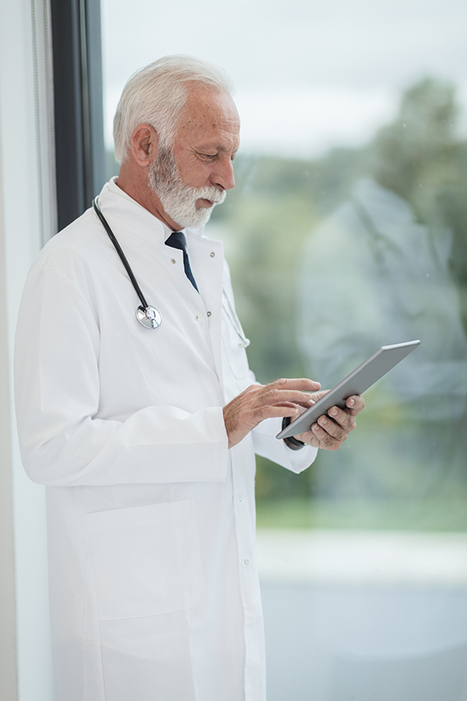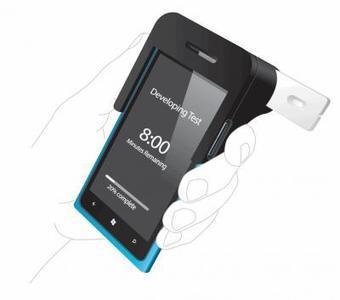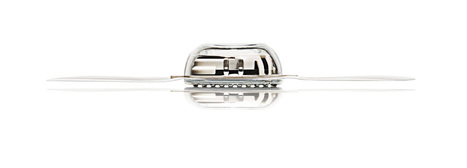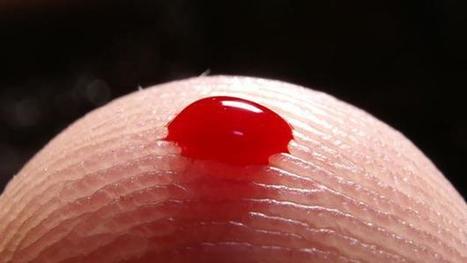 Your new post is loading...
 Your new post is loading...

|
Scooped by
nrip
|
Atypical eye gaze is an early-emerging symptom of autism spectrum disorder (ASD) and holds promise for autism screening. Current eye-tracking methods are expensive and require special equipment and calibration. There is a need for scalable, feasible methods for measuring eye gaze. This case-control study examines whether a mobile app that displays strategically designed brief movies can elicit and quantify differences in eye-gaze patterns of toddlers with autism spectrum disorder (ASD) vs those with typical development. In effect, using computational methods based on computer vision analysis, can a smartphone or tablet be used in real-world settings to reliably detect early symptoms of autism spectrum disorder? Findings In this study, a mobile device application deployed on a smartphone or tablet and used during a pediatric visit detected distinctive eye-gaze patterns in toddlers with autism spectrum disorder compared with typically developing toddlers, which were characterized by reduced attention to social stimuli and deficits in coordinating gaze with speech sounds. What this means These methods may have potential for developing scalable autism screening tools, exportable to natural settings, and enabling data sets amenable to machine learning. Conclusions and Relevance The app reliably measured both known and new gaze biomarkers that distinguished toddlers with ASD vs typical development. These novel results may have potential for developing scalable autism screening tools, exportable to natural settings, and enabling data sets amenable to machine learning. read the study at https://jamanetwork.com/journals/jamapediatrics/fullarticle/2779395

|
Scooped by
nrip
|
Every day, around the world, an estimated 830 women die from pregnancy or childbirth related causes, most in low-income countries. An additional 7000 newborn babies die each day. Many of these deaths could have been prevented. The presence of a skilled birth attendant—doctor, nurse, or midwife—at birth is important to prevent and manage obstetric complications. Supportive care from birth companions can also be helpful to women by bringing support, monitoring, and care to a woman's home throughout pregnancy, labour, and post partum. Imagine if a digital toolkit could be given to pregnant women that combines the ability to individually support, monitor, and inform them, but does it remotely using sensors and apps. It could also incorporate artificial intelligence algorithms to identify patterns of high-risk complications before they occur and could potentially prevent them.

|
Scooped by
nrip
|
Researchers from Intermountain Healthcare have developed a smartphone-based test for measuring salivary cortisol, which can help care providers understand the patient’s stress levels. The test can be performed at the point of care in just five minutes.
When someone feels stress, their body’s natural response is to release hormones, including adrenaline and cortisol, to help them deal with the “threat”. When cortisol is released, it increases glucose in the system, but also curbs nonessential functions including the digestive system, the reproductive system and growth processes.
When people feel stress throughout the day, thus releasing too much cortisol, it can lead to anxiety, depression, digestive problems, heart disease, sleep problems, weight gain, and memory and concentration impairment.
To perform the test, care providers use a smartphone’s camera to take a picture using the flash. From there, the image analysis app can identify the user’s cortisol levels.
“When cortisol levels are overlooked too many people suffer and die because of excess or insufficient cortisol,” lead researcher and Intermountain Medical Center Director of Diabetes and Endocrinology Dr. Joel Ehrenkranz said in a statement.
Ehrenkranz also believes this test will be especially helpful for people with diabetes.
more at http://mobihealthnews.com/34753/intermountain-researchers-develop-smartphone-based-lab-test-for-stress/

|
Scooped by
nrip
|
New research indicates a wireless device could do a better job than the Holter monitor, the standard of care for mobile heart rhythm monitoring over the past half-century.
The Scripps Translational Science Institute compared the Holter monitor with the ZIO Patch, an FDA-cleared, non-invasive, water-resistant device worn on the chest for up to two weeks. STSI, based in San Diego, compared electrocardiograph data from 146 Scripps Green Hospital ambulatory care patients who were fitted with both the ZIO Patch and a Holter monitor.
In all, researchers said, the ZIO Patch, developed by San Francisco-based iRhythm, identified 96 arrhythmia events, while the Holter monitor detected 61.
“This is the first large prospective validation that this new technology superseded the device invented by Norman Holter in 1949,” said Eric Topol, MD, chief academic officer at Scripps Health and STSI's director.
Topol, a cardiologist and lead author of the study, continued in a prepared statement that over the course of tracking every heartbeat for two weeks “the ZIO Service proved to be significantly more sensitive” than the Holter, which consists of a cellphone-sized recorder usually worn about the waist and five to seven lead wires attached to the chest and can only be worn for 24 hours at a time.
“For millions of people who present each year with suspected arrhythmia, this may prove to be the new standard for capturing the culprit heart rhythm electrical disturbance, most commonly atrial fibrillation which carries a significant risk of stroke,” Topol added.
|

|
Scooped by
nrip
|
- The world's largest technology companies have all hired well-known cardiologists.
- Heart disease and high blood pressure affect a large number of people, are well-understood, and there's evidence that consumer products can help.
Big Silicon Valley companies have often competed for talent with specialized skills, like expertise in artificial intelligence or trendy new programming languages. Now they're competing for heart doctors. Apple, Alphabet, and Amazon have all hired well-known cardiologists. This might just be a coincidence. Cardiologists tend to be well educated and hard working, and big tech companies have a track record of recruiting such people. In recent years, all of these companies have started to invest in products and devices that are targeted to millions of people who could benefit by tracking their heart health. Apple's smartwatch now includes an electrocardiogram, which can detect heart rhythm irregularities. Verily's study watch, which is designed for clinical trial research, also tracks heart rate and heart rhythm, and it's doing a lot of work in chronic disease management. So the more likely explanation is that tech companies are interested in health care, and they have all come to the conclusion that cardiology should be an early (if not initial) target. Here's why. It's a huge potential market Heart disease is the No. 1 killer in the world, and strokes are among the leading causes of death. And that's not all that cardiologists treat. "Our scope covers other common disease such as high blood pressure, which impacts about a third of people in the U.S. — 75 million Americans — as well as lipid and cholesterol disorders," said Dr. Mo Elshazly, a cardiologist and assistant professor of medicine at Weill Cornell Medicine. Many cardiologists are also experts in nutrition and exercise science, which impacts a huge number of people who are committed to staying healthy. That's useful for the teams within the largest tech companies that are more focused on wellness and fitness applications, rather than on health and medical. Alphabet has Google Fit. Apple has a fitness group for its Apple Watch. And Amazon is looking at health and wellness applications for its Alexa voice assistant. It's well-studied Cardiology is among the most-studied fields in medicine, meaning there's already a lot of evidence to understand the root causes of heart disease, as well as how to prevent it. That's attractive for tech companies, which tend to base their development decisions on data. Their consumer products are already making a difference Let's take Apple, as an example. The company launched its first Apple Watch model with a heart rate sensor, never expecting that people would use it to discover they were pregnant, at risk for a heart attack or experiencing a dangerous irregular heart rhythm. But as people began sharing examples of how the Apple Watch saved their life, the company started to invest heavily in the science and technology to drive more of these stories. A lot of that work culminated in the first-ever clearance for a heart rhythm sensor called an ECG for Apple Watch earlier in the summer. read more at https://www.cnbc.com/2018/10/17/what-every-tech-company-needs-a-cardiologist.html

|
Scooped by
nrip
|
An object in your pocket could help diagnose rare diseases like Ebola, finds David Robson – and one day it might even replace the doctor’s surgery too.
As fear of the Ebola virus escalates, Eric Topol thinks that we’re missing an important weapon. And you just need to reach into your pocket to find it. “Most communicable diseases can be diagnosed with a smartphone,” he says. “Rather than putting people into quarantine for three weeks – how about seeing if they harbour it in their blood?” A quicker response could also help prevent mistakes, such as the patient in Dallas who was sent home from hospital with a high fever, only to later die from the infection.
It’s a provocative claim, but Topol is not shy about calling for a revolution in the way we deal with Ebola – or any other health issue for that matter. A professor of genomics at the Scripps Research Institute in California, his last book heralded “the creative destruction of medicine” through new technology. Smartphones are already helping to do away with many of the least pleasant aspects of sickness – including the long hospital visits and agonising wait for treatment. An easier way to diagnose Ebola is just one example of these sweeping changes.
So far, however, few doctors have embraced these possibilities. “The medical cocoon has not allowed a digital invasion,” says Topol, “while the rest of the world has already assimilated the digital revolution into its day-to-day life.” That’s not due to lack of demand: many patients are already monitoring their health through their phone, with apps that check your skin for cancer from a selfie, for example. These programs are not alwaysdesigned with the accuracy most doctors would require, however – and some fear that by missing a diagnosis and offering a false sense of security, they could cost lives. “The slower the healthcare system is in exploring these things, the more people are at risk by doing the exploration on their own,” says Estrin.
more at : http://www.bbc.com/future/story/20141017-the-ebola-detector-in-your-pocket

|
Scooped by
nrip
|
Biofeedback of heart rate variability (HRV) was applied to patients with diabetic polyneuropathy using a new mobile device allowing regularly scheduled self-measurements without the need of visits to a special autonomic laboratory.
Prolonged generation of data over an eight-week period facilitated more precise investigation of cardiac autonomic function and assessment of positive and negative trends of HRV parameters over time. Statistical regression analyses revealed significant trends in 11 of 17 patients, while no significant differences were observed when comparing autonomic screening by short-term HRV and respiratory sinus arrhythmia at baseline and after the 8 weeks training period.
The results of this preliminary study indicate a good practicality of the handheld device and suggest a potential positive effect on cardiac autonomic neuropathy in patients with type 2 diabetes.

|
Scooped by
nrip
|
A lightweight and field-portable device invented at UCLA that conducts kidney tests and transmits data through a smartphone attachment may significantly reduce the need for frequent office visits by people with diabetes and others with chronic kidney ailments.
The smartphone-based device was developed in the research lab of Aydogan Ozcan, a professor of electrical engineering and bioengineering at the UCLA Henry Samueli School of Engineering and Applied Science, and associate director of the California NanoSystems Institute. Weighing about one-third of a pound, the gadget can determine levels of albumin in the patient's urine and transmit the results within seconds. Albumin is a protein in blood that is a sign of danger when found in urine.
Ozcan's lab also developed the opto-mechanical phone attachment, disposable test tubes, Android app and software to transmit the data. The research was published this month by the peer-reviewed journal Lab on a Chip ("Albumin testing in urine using a smart-phone").
"Albumin testing is frequently done to assess kidney damage, especially for diabetes patients," Ozcan said. "This device provides an extremely convenient platform for chronic patients at home or in remote locations where cell phones work."
Patients at risk for diabetes, kidney disease and other ailments must regularly provide fluid samples — sometimes more than one a day — to monitor their health, which requires visits to labs or health centers.
The new device projects beams of visible light through two small fluorescent tubes attached to the device, one containing a control liquid and the other a urine sample mixed with fluorescent dyes. The smartphone camera captures the fluorescent light after it passes through an additional lens.
An Android application then processes the raw images in less than one second and the device transmits the test results to a database or health care provider. The test, which measures albumin concentration in urine, is accurate to within less than 10 micrograms per milliliter, according to the research, well within accepted clinical standards used in diagnosing conditions such as microalbuminuria, the excretion of albumin in urine.
The time it takes to conduct a test, including preparation of a sample using a small syringe to inject the urine into a fluorescent tube, is about five minutes. Ozcan estimates that the device — for which his lab also has developed an iPhone app — could be produced commercially for $50 to $100 per unit.
|



 Your new post is loading...
Your new post is loading...
















Identifying autism in toddlers is helpful to starting care for it early. This study's results demonstrate that with an app based approach coupled with an algorithmic approach, it is certainly possible to get possibly affected children in for detailed clinical evaluations earlier and fairly cheaply.
Thus, doctors will be able to install an app on their smartphone/tablet, one that is capable of analyzing the visual gaze of a toddler in order to determine if they may be on the autism spectrum.
And, in time, parents and family members will be able to download it onto their own smartphones/tablets carry out the screening themselves.